
Springfield Armory NHS, US NPS The story of Springfield Armory is more than a progression in the improvement and effectiveness of military weapons. It is also a history of industrial technology. Very early the Connecticut River Valley became an industrial center of the United States where a healthy competition between arms manufacturers existed. The government armory was a leading participant in that competition. The result was parallel development of the weapons and the machines, techniques, and skills used to produce those weapons. For centuries many of the same techniques have been used to produce firearms. The evolution, as exemplified by the history of Springfield Armory, has been in the shift from hand work to machine work: hand forging, or blacksmithing, has given way to machine forging; hand filing to machine cutters. 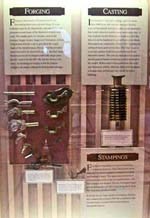
Springfield Armory NHS, US NPS This display case describes three metal-shaping processes: forging, casting, and stamping. 
Springfield Armory NHS, US NPS 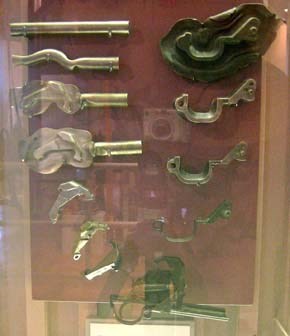
Springfield Armory NHS, US NPS The trigger assembly of the M1 was made up largely of forgings. The forging process compacts the metal making it stronger. The steps in making the hammer and trigger guard are shown in the examples above. 
Springfield Armory NHS, US NPS 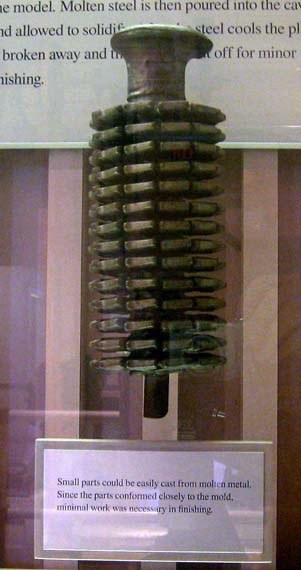
Springfield Armory NHS, US NPS Investment or “lost wax” casting, a process more than 4,000 years old, was introduced in the last years of Springfield Armory to make complicated parts that would otherwise involve many machining steps. A wax or plastic model of the part is made in molds like these or can be machined or carved from a solid block. These parts are connected to form a “tree” enabling the casting of many parts at one time. The “tree” is put in a can and a plaster material is poured around it and allowed to harden. The cans are then placed in an oven and the pattern burned out leaving a cavity identical to the model. Molten steel is then poured into the cavity and allowed to solidify. After the steel cools the plaster is broken away and the parts are cut off in minor finish. 
It was the use of a large number of stampings that gave the commercially produced M16 the competitive edge over the finely machined M14 manufactured at Springfield Armory. Springfield Armory NHS, US NPS 
Springfield Armory NHS, US NPS During the early 1950s it was found that non-critical items, such as the trigger guard, could be made less expensively from metal stampings. M1s built during and after the Korean Conflict can be identified by their stamped metal trigger guards.
**************************************

Springfield Armory NHS, US NPS 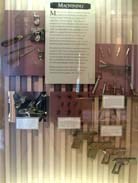
Springfield Armory NHS, US NPS The introduction of machinery made interchangeability a practical matter. The new generation of machines introduced in the mid-nineteenth century, coupled with a system of gauges developed by armory employees like Cyrus Buckland and Erskine Allin, resulted in the first fully interchangeable machine-made weapons. Modern machine tools have taken the process a step further, turning out parts to tolerate that can be measured in the thousandths (.001) of an inch. 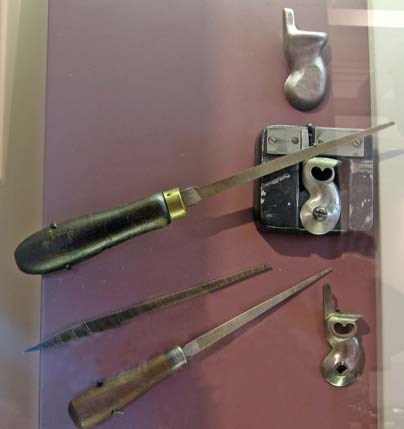
Springfield Armory NHS, US NPS Modern machine cutters have replaced filing and grinding in the production of finished parts from the forgings. In the early days of the armory, much of this work was done by hand so the parts produced were not interchangeable with similar ones in other muskets. The hard steel guides and patterns, which came later, helped control the filing, but as the patterns wore away the parts became less identical. The final fitting that was necessary to make each musket work caused each musket to be unique. Characteristic of such hand-finished weapons are the identifying marks stamped on each component part. 
Springfield Armory NHS, US NPS 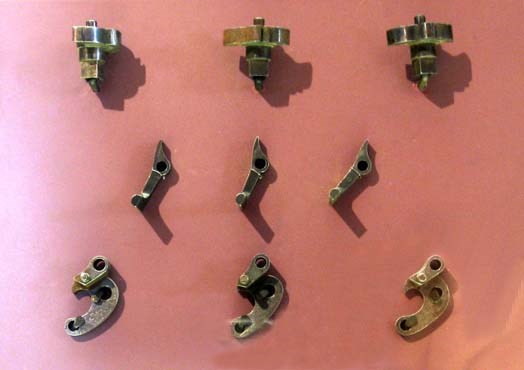
Springfield Armory NHS, US NPS The era of interchangeability began with the introduction of machines that could manufacture great numbers of identical parts. By the 1840s it was no longer necessary to hand fit each lock and the identification marks were no longer needed. 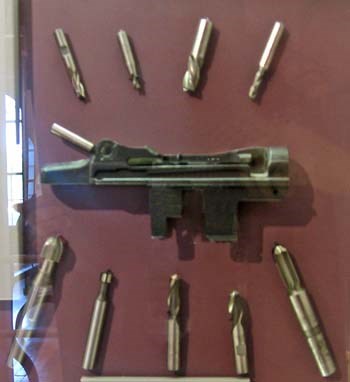
Springfield Armory NHS, US NPS With the advent of the M1 rifle, hand work was almost totally eliminated from the manufacturing process. Not only did new tools have to be developed to perform the intricate tasks, but the weapons had to be designed around machine capabilities. John Garand worked on both sides of the problem, designing the M1 and the process with which to build it. 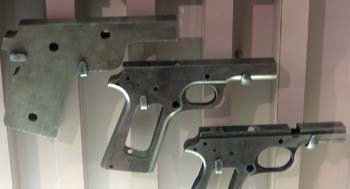
Springfield Armory NHS, US NPS The increased sophistication of weapons increased their cost, and ways were sought to reduce those costs. One such experiment involved cutting the M1911 pistol frame from metal stock, rather than making it from forgings.
******************************** 
Springfield Armory NHS, US NPS 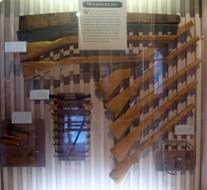
Springfield Armory NHS, US NPS When the Armory began production of the M1795 musket it took fourteen man-hours to produce a gun stock. By the time of the Civil War machines could turn out fourteen gun stocks an hour. In the 1950s, when the M1 was in production, Armory workers could produce one stock per man per minute. The basic steps in production of gun stocks have not changed significantly over the years. This series of gun stocks shows the production steps. Shaping, inletting, and finishing have all been performed by machine. Also note the grooved cutter marks left by the modern Blanchard eccentric lathe. 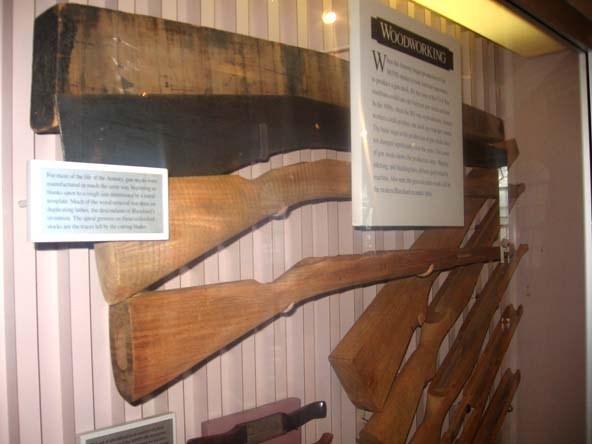
Springfield Armory NHS, US NPS 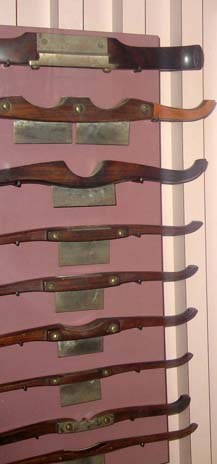
Springfield Armory NHS, US NPS This set of specialized tools used for the final shaping of the M1903 rifle represents elegant tools made by a craftsman for his own use. The first is a spokeshave for precise shaping; the others are contoured scrapers. Properly employed they leave a wood surface ready for finishing. 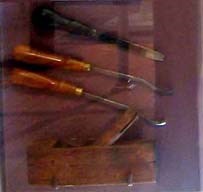
Springfield Armory NHS, US NPS Once the lathe has completed its work, finishing of the stock required the skills of a specialist. Many of the tools of the stock maker were very similar, if not identical, to those used by the cabinet maker: chisels, planes and draw knives. However, some specialized tools, such as the round off-set file used to smooth the ramrod groove, would only have been found in the stockmaker’s tool box. 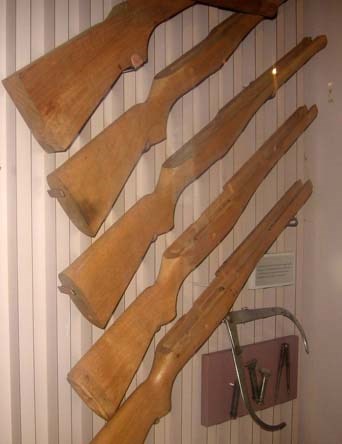
Springfield Armory NHS, US NPS The M14 was the last infantryman’s weapon manufactured at the Springfield Armory and the stages in manufacture demonstrate the most modern techniques used in making wooden stocks. 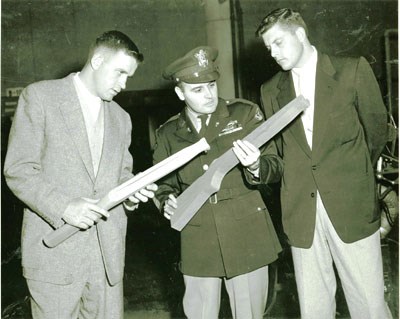
Springfield Armory NHS, US NPS |
Last updated: February 26, 2015
